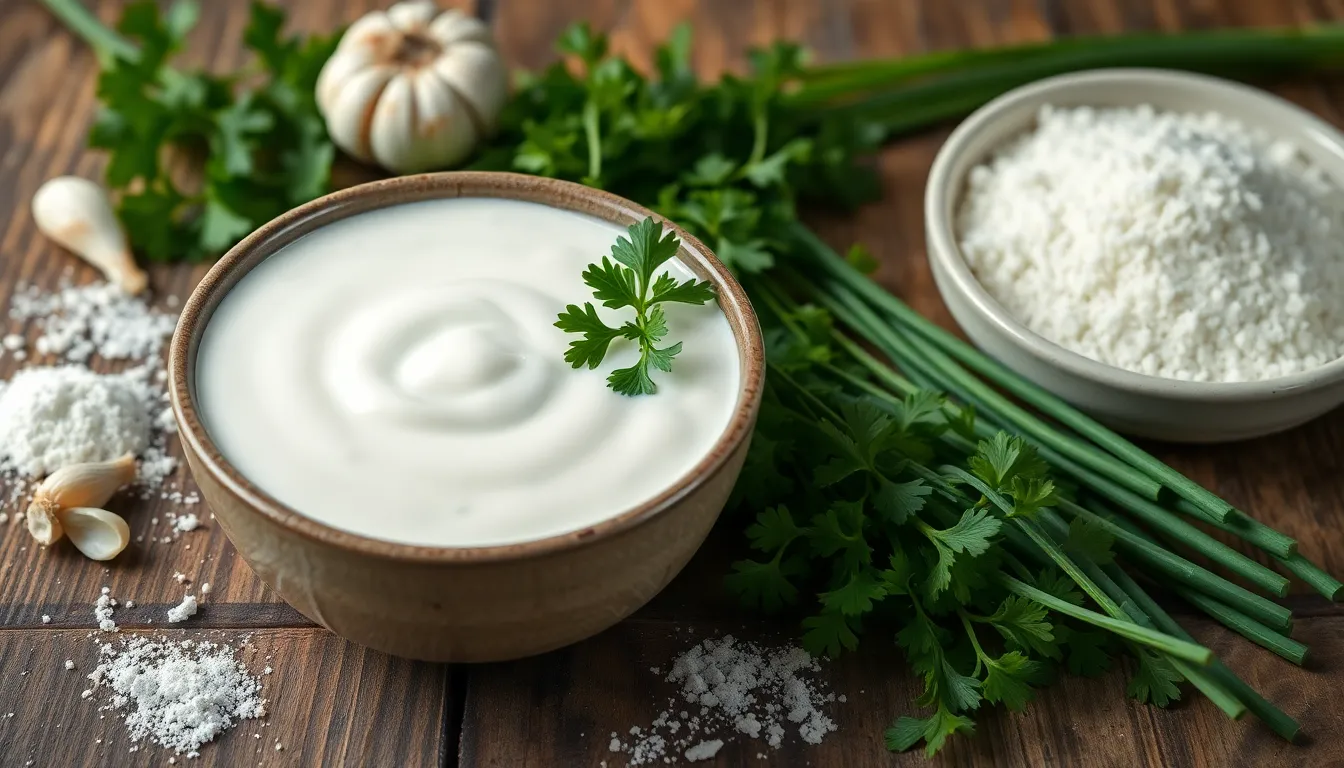Ranch dressing has become a staple in kitchens and restaurants across the country. Its creamy texture and zesty flavor make it a favorite for salads, dipping, and even as a condiment for various dishes. But what exactly goes into this beloved dressing? Understanding its ingredients not only satisfies culinary curiosity but also helps those with dietary restrictions make informed choices.
At its core, ranch dressing combines a few key components that work together to create its signature taste. From buttermilk to herbs and spices, each element contributes to the overall flavor profile. Digging deeper into the composition of ranch dressing reveals the secrets behind its popularity and versatility, making it a must-know for any food enthusiast.
Table of Contents
ToggleUnderstanding Ranch Dressing
Ranch dressing features a creamy texture and zesty flavor derived from its key ingredients. Knowing what it’s made of helps in appreciating its culinary versatility and suitability for various diets.
Origin of Ranch Dressing
Ranch dressing originated in the 1950s in Hidden Valley Ranch, California. Its creator, Steve Henson, developed the recipe while catering for a dude ranch. Initially, ranch dressing gained popularity among guests before it became a staple in grocery stores. It commonly includes buttermilk, sour cream, mayonnaise, and a mix of herbs and spices, establishing itself as a beloved condiment across the United States.
Popular Variations of Ranch
Ranch dressing comes in several variations to cater to different tastes. These include:
- Spicy Ranch: Incorporates ingredients like hot sauce or cayenne pepper, delivering a spicy kick.
- Chipotle Ranch: Features chipotle peppers, adding a smoky flavor to the traditional ranch.
- Avocado Ranch: Blends creamy avocado into the ranch dressing, providing a rich and smooth texture.
- Greek Yogurt Ranch: Substitutes sour cream with Greek yogurt, offering a healthier option with added protein.
These variations maintain the classic ranch flavor while introducing unique twists, making them appealing to a broader audience.
Key Ingredients in Ranch

Ranch dressing consists of several essential ingredients that contribute to its creamy texture and bold flavor. Understanding these components clarifies their role in crafting this beloved condiment.
Base Components
- Buttermilk: Buttermilk serves as the primary base, providing creaminess and a tangy flavor.
- Mayonnaise: Mayonnaise adds richness and thickness, enhancing the overall texture.
- Sour Cream: Sour cream contributes to the creamy consistency while introducing a slight acidity.
Flavor Enhancers
- Garlic Powder: Garlic powder imparts a distinct savory note, elevating the flavor profile.
- Onion Powder: Onion powder offers sweetness and depth, balancing the other ingredients.
- Herbs: Parsley, dill, and chives are common herbs that infuse freshness and brightness into the dressing.
- Black Pepper: Black pepper introduces a subtle heat, enhancing the overall taste experience.
- Salt: Salt acts as a flavor enhancer, bringing all components together for a harmonious finish.
Nutritional Profile of Ranch Dressing
Ranch dressing, while popular, contains specific nutritional elements worth examining. Understanding these components aids in making informed dietary choices.
Caloric Content
Ranch dressing’s caloric content typically ranges from 70 to 150 calories per two-tablespoon serving. This variance depends on the recipe or brand, especially with variations like light or reduced-fat options. Traditional ranch generally contains around 140 calories, largely derived from fats in mayonnaise and sour cream. Keeping track of portion sizes is essential for those monitoring caloric intake.
Common Additives
Ranch dressing often includes additives to enhance flavor and preserve freshness. Common additives are:
- Preservatives: Used to extend shelf life, examples include calcium propionate and potassium sorbate.
- Thickeners: Ingredients like xanthan gum or guar gum maintain the desired texture.
- Natural Flavors: These enhance the overall taste, though the exact formulations vary by brand.
- Sugar: Some recipes contain added sugar to balance flavors, with amounts typically around 1 gram per serving.
Familiarity with these additives helps consumers better navigate their dietary restrictions and preferences.
How to Make Ranch at Home
Making ranch dressing at home ensures control over ingredients and flavors, allowing for a personalized touch. Here’s how to create a traditional version and adapt it for healthier preferences.
Traditional Recipe
- Gather Ingredients: Use 1 cup buttermilk, 1 cup mayonnaise, and 1/2 cup sour cream.
- Combine Base: In a mixing bowl, whisk together the buttermilk, mayonnaise, and sour cream until smooth.
- Add Seasonings: Incorporate 1 teaspoon garlic powder, 1 teaspoon onion powder, 1 tablespoon fresh chopped parsley, 1 tablespoon fresh chopped dill, 1 tablespoon fresh chopped chives, salt, and black pepper to taste.
- Mix Thoroughly: Blend all ingredients until fully combined. Refrigerate for at least 30 minutes to allow flavors to meld.
Alternatives for a Healthier Version
- Low-Fat Options: Replace regular mayonnaise with Greek yogurt and use low-fat buttermilk.
- Dairy-Free Substitutes: Utilize almond or coconut yogurt in place of sour cream and mayonnaise for a vegan creation.
- Herb Variations: Switch fresh herbs for dried counterparts, using 1-2 teaspoons of each, to maintain flavor without adding calories.
- Flavor Enhancers: Experiment with lemon juice or vinegar for added acidity without extra fat, enhancing the dressing’s freshness.
These steps provide straightforward methods to prepare ranch dressing that aligns with various dietary needs and preferences.
Ranch dressing stands out as a beloved condiment that enhances a variety of dishes. Its creamy texture and zesty flavor make it a staple in many kitchens. Understanding its ingredients not only enriches culinary knowledge but also helps individuals with dietary needs make informed choices.
With numerous variations available, there’s a ranch dressing for everyone, whether they prefer a spicy kick or a healthier twist. Making ranch at home allows for personalization, ensuring that each batch meets specific tastes and dietary requirements. Ultimately, ranch dressing remains a versatile favorite that continues to delight palates across the globe.



